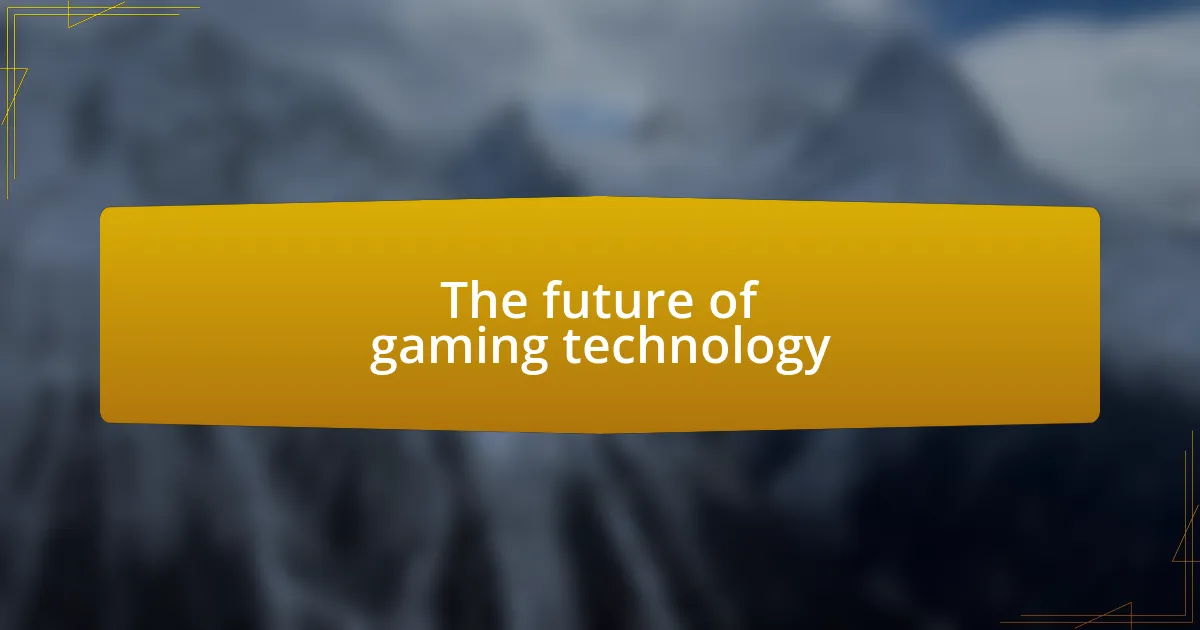Key takeaways:
- The evolution of gaming technology includes key milestones such as the shift to 3D graphics, online gaming, mobile gaming, and advancements in AI and VR.
- Current trends like cloud gaming, augmented reality, and inclusivity in game design are reshaping player experiences and accessibility.
- The future promises immersive experiences through enhanced VR, AI-driven narratives, and blockchain technology for true ownership of in-game assets.

Introduction to gaming technology
Gaming technology has evolved dramatically over the past few decades, transforming how we interact with digital entertainment. I remember the first time I played video games on a clunky console, and now, we’re entering an era where cloud gaming and virtual reality redefine our experiences. How often do we stop to think about the technology that drives these incredible advancements?
Each leap in gaming tech, whether it’s enhanced graphics or immersive gameplay, captivates players and draws them deeper into virtual worlds. For instance, I was astounded by the realism of motion capture in games like “The Last of Us Part II.” This kind of detail makes players feel an emotional connection, and it’s fascinating to consider how technology can elicit such powerful feelings.
The interplay between hardware and software in gaming creates an ever-changing landscape full of possibilities. As I explore these innovations, I’m often struck by the question: what does the future hold? With advancements like artificial intelligence and machine learning becoming integral to game design, it’s thrilling to think about the potential for even more immersive and engaging experiences on the horizon.

Evolution of gaming technology
The evolution of gaming technology has been a remarkable journey. I remember playing on game cartridges with limited graphics, and then watching as 3D environments began to emerge. It was almost like witnessing magic unfold when we moved from 8-bit sprites to vivid landscapes. This progression didn’t just enhance visuals—it completely changed how I experienced stories.
Some key milestones in this evolution include:
- The shift from 2D to 3D graphics, making environments feel more real.
- The introduction of online gaming, allowing players to connect globally.
- The rise of mobile gaming, making gaming accessible anywhere and anytime.
- The development of virtual reality, immersing players in fantastical worlds.
- Advancements in artificial intelligence, creating more dynamic and responsive gameplay.
Looking back at these milestones, I can’t help but feel excited about what’s next. Each innovation feels like a personal invitation to explore new and uncharted territories in gaming.

Key trends in gaming technology
Key trends in gaming technology are constantly evolving, and it’s fascinating to see where they are taking us. One significant trend is the rise of cloud gaming, which allows players to access games without needing powerful hardware. I remember when I used to worry about whether my computer could handle the latest titles. Now, with just a stable internet connection, the gaming experience has become much more accessible.
Another exciting trend is the incorporation of augmented reality (AR) into games. I recall playing Pokémon GO and the thrill of seeing virtual creatures blend into my real-world environment. This technology is transforming how we perceive and interact with our surroundings in gameplay, creating unique experiences that were unimaginable a few years ago.
Furthermore, the focus on inclusivity and diversity in gaming is gaining momentum. More games are being designed to cater to different demographics and abilities. The first time I played an adaptive game designed for players with disabilities, I was amazed at how tailored experiences could put enjoyment at the forefront, making gaming enjoyable for everyone.
| Trend | Description |
|---|---|
| Cloud Gaming | Access games without powerful hardware through the internet. |
| Augmented Reality (AR) | Blends virtual elements with real-world environments. |
| Inclusivity in Gaming | Designing games for diverse demographics and abilities. |

The future of gaming technology
The future of gaming technology promises to be an exhilarating journey. I envision advancements in virtual reality (VR) that create truly immersive experiences, allowing players to step into worlds they’ve only dreamed of. Just thinking about the first time I tried VR—the rush of exploring a virtual environment—makes me excited for how much more lifelike these experiences will become.
As we look ahead, artificial intelligence (AI) will play a massive role in shaping gaming narratives and experiences. Imagine playing a game where the characters adapt to your choices in real-time, enhancing the emotional engagement. I can still remember being completely absorbed in a story-driven game, and I can’t help but wonder how AI could elevate that feeling to unprecedented levels.
Moreover, we’ll likely see more integration of blockchain technology in gaming. This could redefine ownership, allowing players to truly own in-game assets. I think back to the hours I’ve spent grinding for rare items, and the prospect of actually owning those items and trading them sounds incredibly appealing. Who wouldn’t want a piece of their favorite game they could showcase or sell?

Tips for embracing new technology
Embracing new technology can feel overwhelming, but starting small is key. I remember when I first experimented with VR; it was just one game that changed my perspective on gaming entirely. By selecting a single piece of new tech to try out, you allow yourself to gradually adapt, reducing the intimidation factor.
Stay informed about the latest trends and developments in gaming technology. I often find myself scrolling through gaming blogs or social media to see what innovations are on the horizon. For example, joining discussions in online forums can provide insights that enhance your understanding and appreciation of new tools and platforms.
Don’t hesitate to seek community or expert advice as you navigate new technological landscapes. When I was first learning about blockchain in gaming, I reached out to peers who were more experienced, and those conversations were enlightening. Connecting with others brings different perspectives and experiences, making the transition smoother and more enjoyable.

Conclusion and personal insights
As I reflect on the ever-evolving gaming technology landscape, I recognize just how transformative these advancements have been for my gaming experience. It feels almost surreal to think about how far we’ve come—remembering late-night sessions spent with pixelated graphics and now being captivated by hyper-realistic worlds. I often wonder, what’s next? It’s exciting to imagine how innovations like AI and cloud gaming will shape our future interactions.
I’ve noticed that being open to change has completely reshaped my enjoyment of gaming. There was a moment, during a multiplayer VR game, when I was completely immersed—not just in the game, but in a shared experience with friends from across the globe. The emotional connection I felt, laughing and strategizing together, was something I never expected from technology. It makes me appreciate the potential for tech to bridge distances and unite us.
In my journey, I’ve come to believe that embracing new gaming technology isn’t just about enhanced graphics or streamlined gameplay; it’s about connection and community. Each piece of technology I adopt opens new doors to experiences and friendships I hadn’t imagined. So, I ask you: how have your interactions with technology shaped your own gaming memories? Isn’t it powerful to think about the stories we create in these virtual spaces?















